Recipes
Disclaimer: Eating any food or a concentrated natural product is a decision based on personal research and understanding. Food-derived antioxidants, minerals and enzymes play an important role in your health. The information The Body Works! Neuromuscular Reeducation, LLC provides in this website is for educational purposes only and is not intended as a substitute for advice from a health care professional. It should not be used for diagnosis or treatment of any health problem or construed as a prescription of a medication or other treatment. We cannot and do not claim that the products we offer will prevent, cure, treat or diagnose a disease in humans or animals. Natural healing is inherently unpredictable, and results will vary widely.
Tamari Broth (A. Kushi)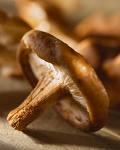
2 Shiitake mushrooms
1/4 c sliced scallions for garnish
4 cups spring water
1 sheet toasted Nori for garnish
1 3-inch piece of Kombu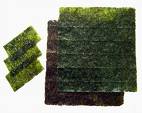
1 pkg. tofu, cubed (optional)
2-3 tblsp Tamari soy sauce
1. Soak the Shiitake mushrooms and Kombu for 10 to 20 minutes; drain and reserve water. Discard the stems.
2. Put the Kombu and Shiitake in the water (plus the soaking water) and boil for 3-4 minutes.
3. Remove the Kombu and Shiitake and save for another recipe.
4. Add the tofu and boil until the tofu comes to the surface. Do not boil the tofu too long or it will become hard. Tofu in soup is best enjoyed soft.
5. Add the Tamari soy sauce and simmer for 2 to 3 minutes.
6. Garnish with scallions and Nori.
Sweet Stew(C. Cesare)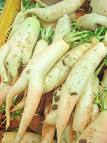
Basic Recipe
1 Daikon Radish
1 Carrot
1 Onion 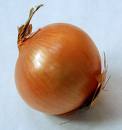
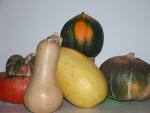
1 Winter Squash
Herbamare* Seasoning or Sea Salt to taste
1. Scrub the vegetables with a vegetable brush under lukewarm water making sure not to bruise the vegetables and leaving the tops and root ends in tact.
2. Slice the daikon into half-moon shapes. Slice the carrots into rounds. Cut the onions in half from top to bottom then slice into thin pieces from top to bottom. Slice the squash in half and scoop out the seeds, then slice into chunks.
3. Place all ingredients into a crock pot and add enough spring water to cover the vegetables. Turn heat to low. Allow to cook 4-6 hours or overnight.
*Herbamare is a blend of organic herbs and sea salt
Variations of this recipe can be made as long as the basic ingredients are used:
For Healing/Cleansing 
Basic recipe
1 small or 1/2 large burdock root sliced on the diagonal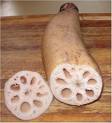
1 small to medium lotus root quartered then sliced
1-2 Shiitake mushrooms (fresh is best, but dried can be used after soaking for 10 min.)
Italian Version
Basic recipe
1 fresh tomato, peeled & chopped
1 medium green bell pepper, sliced
1 cup fresh green beans
2/3 cup green lentils, washed & sorted
1-2 cloves garlic, sliced
fresh sage, fresh thyme, fresh basil, fresh oregano
Pressure Cooked Brown Rice (A. Kushi)
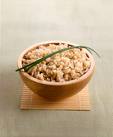
2 cups organic brown rice
Pinch of sea salt per cup of rice
1 1/4 to 1 1/2 cups of spring water per cup of cup of rice
** 1 tsp. fresh or 1/2 tsp dried organic thyme may be added to improve digestibility
1. To prepare rice for cooking, place a handful at a time on a dinner plate and pick out any visible stones, particles of soil, or heavy dust. Place the rice in a pot or bowl and cover with cold water. Gently wash the grain by stirring with your hand in a counter-clockwise direction. Drain off the water. Repeat the washing until the drain water is clear.
2. After washing, if there is time, soak the rice 2-3 hours or overnight in a glass bowl. Soaking increases digestibility of the grain. DO NOT soak rice (or beans) in metal as this will contaminate the food. If time does not allow, the rice may be pressure cooked directly after washing.
3. Pressure cooking is the quickest and most thorough way to prepare whole grains. When cooked each grain should be separate and distinct and the rice should taste sweet. Place the rice in the pressure cooker and smooth out the surface of the rice so that it is level. Slowly add the spring water down the side of the pressure cooker so that the surface of the rice remains calm and even.
4. Put the pressure cooker on the stove and begin to cook over low heat. When the water begins to bubble (after 10-15 minutes) add the sea salt. Tighten the cover of the pressure cooker securely and bring slowly up to pressure. This is signified by the hissing, jiggling, or spinning of the gauge. If cooking on gas, place a flame deflector under the pot and reduce heat. If cooking with electric, reduce heat to low. Cook for 50 minutes.
5. When the rice is done, remove the pressure cooker from the heat and allow it to stand for at least 5 minutes before reducing the pressure and removing the cover. If you wait 10-15 minutes for the pressure to come down naturally before opening, the rice will be even better. This wait allows any burnt or scorched grains on the bottom to loosen.
6. Using a bamboo rice paddle or wooden spoon, lift the rice from the pressure cooker one spoonful at a time and smooth into a large wooden bowl. Distribute evenly the heavier, well-cooked rice at the bottom and the lighter, fluffier rice at the top. Alternating scoops in this way makes for a more balanced bowl of rice.
Rice pressure-cooked in this way will have a delicious, nutty, naturally sweet taste and will impart a very peaceful, strong feeling.
Millet & Carrots
2 cups millet
Pinch of sea salt per cup
2 1/2 to 3 cups boiling water per cup of millet
1 carrot, grated
Safflowers for garnish
1. Wash millet in a strainer.
2. Dry roast the grain in a large skillet stirring often until the grains begin to pop and release a pleasant aroma.
3. Add the boiling water, salt, grated carrots, and stir.
4. Bring to a boil again, cover, and lower heat. Simmer for about 30 -35 minutes until the water is evaporated and the grain puffs up.
5. In the last 10 minutes sprinkle the safflowers on the top.
Transfer to a large bowl or plate to serve.
Garbanzo Beans (Chick Peas) (Turner)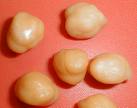
1 cups garbanzo beans
1 3-inch piece of Kombu
1/4 tsp. sea salt
5 cups spring water
1. Wash, sort and soak the beans in 2 cups of spring water 6 hours or overnight in a plastic or glass dish.
2. Soak the kombu for 10 minutes or longer until soft. Dice the kombu in 1/2 inch pieces.
3. Lay the kombu in the bottom of a pressure cooker. Place the drained beans on top. Add 3 cups spring water to pressure cooker.
4. Bring to a boil. Skim off any foam that forms. Add salt, cover and bring to pressure. Cook over medium heat for 1 1/2 hours.
Strain, transfer to a serving dish and serve. Leftovers are great added to soups or stews.
Hijiki Kinpira(Kushi) 
1 carrot, sliced into matchsticks
1 package Hijiki sea weed
1 lotus root sliced into matchsticks
2-3 tblsp light or dark sesame oil
1 burdock root sliced into matchsticks
Sea Salt
1. Wash Hijiki to remove sand, dirt, or tiny seashells. Throw away the wash water, then soak in spring water for 10 minutes.
2. Slice the vegetables into matchsticks and place in separate bowls.
3. Measure oil into large skillet. Add burdock, lightly salt, and sauté 1-2 minutes. Stirburdock root, lightly salt again and sauté 1-2 minutes.
4. Add carrots and lotus root. Sauté with burdock root 4 minutes.
5. Add Hijiki along with soaking water. Cover, bring to boil, then lower heat and simmer for about 30 minutes. Check to make sure there is enough water to keep the vegetables from sticking. The Hijiki will have swelled to 6 times its original size!
Serve small quantities, warm or cooled as a side dish.
Gomashio(Kushi)
1 cup black or white sesame seeds sea salt
1. Wash seeds in a very fine strainer and drain. Any seeds that float on top should be discarded.
2. Dry-roast the seeds in a frying pan when still wet as they will cook more evenly. Do not roast too many seeds at once or they will burn. The seeds are done when they crush easily between the thumb and index finger, about 5-10 minutes. They will pop and give off a nutty aroma when done.
3. Place the seeds in a suribachi (a Japanese mortar and pestle) and grind with salt until each seed is half-crushed. Salt should be added according to taste. 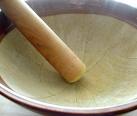
4. Allow the gomashio to cool before placing in an air-tight container.
Fresh gomashio is best. Make small batches at a time and serve over rice or with mochi.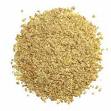
Ginger Carrot Breakfast Cookies(Turner)
3/4 cups rolled oats
2 cups cooked millet
1/2 cup oat flour (millet, quinoa may be substituted)
1/4 tsp. sea salt
1/4 cup brown rice or barley flour
1 cup finely shredded carrot
1 1/2 tblsp corn oil (sesame or safflower may be substituted)
1 tsp. vanilla (optional) 1 tsp. finely grated ginger
1 tblsp poppy seeds or sunflower seeds
1/3 cup chopped almonds (optional)
1/2 cup water (approx.) 1/3 cup chopped raisins (optional)
1/3 cup rice or barley malt syrup (optional)
Lightly roast oats and flours by stirring over medium heat in a skillet, until toasty smelling but not browned. Mix all ingredients & add just enough water for a moist, pliable but not mushy dough. Shape into cookies on an oiled baking sheet. Bake at 350* for 30 minutes.
Apple Crisp 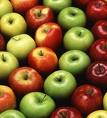
3 large or 4 medium apples
1/2 tsp. salt
1 cup rolled oats
1/4 tsp. allspice
2/3 cup millet flour
1/3 tsp. cinnamon
1/2 cup raw almonds, ground
1/2 to 1 cup apple juice or cider
1/2 cup raw sunflower seeds, ground
1/4 cup + 1 tblsp safflower or sesame oil
1/2 cup maple syrup or brown rice syrup
1. Mix dry ingredients together.
2. Add oil and sweetener and toss until crumbly.
3. Wash and slice apples. Core the apples but leave on the skin.
4. Put one layer of apples in a square baking dish.
5. Spread a layer of crumbly mixture evenly over apples.
6. Continue to layer sliced apples and crumbs with the last layer a thick crust of crumbs.
7. Pour apple cider or juice down the side of the pan.
8. Bake at 350* for 45-55 minutes or until golden brown on top.
Allow to cool slightly before serving. May be served alone or with soy milk.
Bancha Tea(Turner)
Roast the whole package of twigs to revive flavor by stirring in a skillet over medium heat for a few minutes. Store in a tightly sealed jar. Boil water in a glass pot and add about 1 tsp. per cup. Simmer 10 minutes or until desired strength. Re-use twigs 2 or 3 times . . . just add a little more water and fresh twigs.
Grain Coffee (or Yannoh)
1 cup brown rice 1 cup millet
1 cup oat groats 1 cup barley
1 cup rye 1 cup adzuki beans or mung beans
1 cup roasted chicory root 1 cup roasted dandelion root
1. Separately wash each grain and the beans and drain
2. Dry roast each ingredient separately in a skillet until dark in color, stirring often to prevent burning.
3. Cool, then grind to a fine-medium course powder.
4. Mix all ingredients together.
5. Brew coffee using 1 tsp. per cup. If ground to a medium coarseness, a regular drip coffee pot may be used to brew.
6. Coffee may be served plain or with rice syrup and soy milk.
** Dried & roasted ground burdock root and burdock seeds may also be added
Basic Chili
1-2 tblsp olive oil
1 medium sized onion, chopped
3 medium fresh tomatoes, peeled & chopped
4 cloves garlic, minced 1 can kidney beans
1 jalapeno pepper, chopped 2 cans tomato sauce
1/2 large bell pepper, chopped 2 tsp chili powder, or to taste
1 lb. ground turkey 1 finely grated carrot (to cut acidity & sweeten)
salt, pepper, garlic powder, onion powder to taste
Heat oil in a large skillet. Sauté onions and garlic until opaque. Add chopped peppers & sauté until tender. Add ground turkey. Stir constantly, breaking turkey into small pieces and cook until done. Add tomatoes, grated carrots, kidney beans, tomato sauce and seasonings. Simmer until thickened, about 1 hour. Serve over brown rice.
Flax Oil Dressing
1/4 cup spring water
1/4 cup umeboshi plum vinegar
1/2 cup flax seed oil
1 clove elephant garlic, minced
2 tsp mixed Italian seasoning (oregano, basil, thyme, sage, marjoram, etc.)
pepper to taste
Mix water and umeboshi vinegar in a 1 pint jar. Add minced garlic and seasonings and shake well. Let sit for 15 minutes. Add flax seed oil and shake well. Serve. Store in sealed jar in the refrigerator up to 2 weeks.
Holiday Nuts 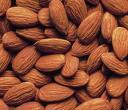
These amounts are estimates. They can be adjusted to your personal tastes.
1 1/2 cup whole almonds 1 T barley malt syrup
1 T rice syrup 1 cup Gomashio
Place 1/2 cup of Gomashio in a shallow bowl.
Wash the almonds and let drain. Dry roast the almonds in a frying pan stirring often to prevent burning. You may need to experiment with the timing for roasting. Almonds are done when they smell roasted, begin to pop, and start to turn dark. Avoid over-roasting as the almonds will continue to cook after removed from heat. When almonds are roasted, add barley malt and rice syrup. Add more syrups if you like a sweeter taste, however adding more sweetener will necessitate more Gomashio at the end to coat the nuts. Continue to stir and cook until the syrups begin to caramelize and turn brown. IMMEDIATELY turn the almonds into the shallow bowl with the Gomashio. Continue to stir until coated. Add the rest of the Gomashio held in reserve and continue stirring. Allow to cool and serve.
Roasted Trail Mix 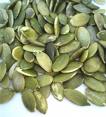
1 cup whole almonds
1/2 cup pumpkin seeds (pepitas)
1/2 cup sunflower seeds
1/3-1/2 cup raisins
2-3 T Tamari soy sauce
First wash and drain the almonds and seeds. Place the almonds in a frying pan and dry roast, stirring often, until almost done. Add the pumpkin seeds (pepitas) and roast until they expand and begin to pop. Add the sunflower seeds and continue until almost done. Add the tamari soy sauce. Use more tamari for a saltier mix; less tamari for a less salty mix. Add the raisins and continue stirring. Mix is done when the tamari is dry and the nuts and seeds are well coated. Allow to cool and serve.
Escarole Soup
1 cup Goya Small White Beans or dry Navy Beans
Wash and sort beans in a bowl of water. Discard beans that float. Soak in a glass bowl for 6 hours or over night. Discard the soaking water. Soak 1- 6” piece of Kombu sea weed for 20 minutes to soften. Do not wash off any white discoloration. These are natural sea water minerals. Chop into small pieces. Combine Kombu, beans, and 4 cups water in pressure cooker. Bring to a boil. Skim foam off the top. Add 1 tsp. salt, cover and bring to pressure. Cook under pressure for 45 minutes. Pressure can be released by placing cooker under cold running water, or let pressure come down naturally. (Beans can be prepared in advance.)
While beans are cooking take (these proportions are estimates – they may be altered to suit your tastes)
4 cloves fresh garlic, minced 1 medium onion, minced
2 – 3 Tblsp Olive Oil 2 Cups fresh chopped escarole
and sauté until the onions and escarole are clear. Escarole should be bright green.
When beans are cooked, add vegetables and season to taste with Herbamare seasoning, black pepper, and Oregano. Simmer together for about 15-20 minutes until flavors marry.
Serve hot.
Celery Soup
Soak 1 – 6” piece of Kombu seaweed and 3 Shiitake Mushrooms in 4 cups of water for 20 minutes in a porcelain or glass pot. Bring to a boil, then reduce heat and simmer for 20 minutes. Remove and save for another recipe. This forms the stock.
Sauté 1 chopped onion and 3 stalks celery (cut on the diagonal) in about 1-2 Tblsp safflower or olive oil until celery is bright green in color. Add to stock and simmer for 20 minutes. Season with Herbamare or Tamari Soy Sauce. Serve hot with Nori seaweed flakes for garnish. (firm tofu cubes may also be added at the end for variety) This is a very light soup good as an appetizer before a heavy meal to prepare the digestion.
Kicharee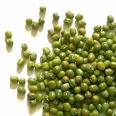
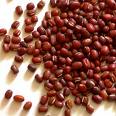
1/2 c mung beans or adzuki beans
1 piece kombu seaweed
1/2 c brown rice
pinch sea salt
1 tsp Coriander
1 tsp Turmeric
1 tsp Cumin
1 Tblsp Ghee (clarified butter)
Wash and sort beans and cook with kombu in 1 cup spring water. Wash rice and cook with a pinch of sea salt in 1 cup spring water. When beans and rice are done, heat ghee to melt. Roast spices in ghee until fragrant. Add cooked beans and brown rice and stir well. Add 1 cup spring water and simmer for 20 minutes until absorbed. Serve hot.
Other spices can be added for their healing properties and additional flavor: garlic, dried powdered ginger, cayenne pepper.
Tasty Dipping/Marinade Sauce
¼ cup Tamari Soy Sauce
1 TBLSP Fresh ginger juice, squeezed from fresh grated ginger
1 clove garlic, crushed
2 TBLSP Toasted Sesame oil
Combine all ingredients and pour over steamed greens, or as a marinade for chicken, fish or meat before cooking.
Chicken and Bitter Greens

1 lb chicken breast, cleaned and cubed
1 Bunch bitter greens (e.g.,Broccoli rabe, kale, endive)
3 TBLSP Extra Virgin Olive Oil
½ Tsp Herbamare seasoning salt
3 cloves fresh garlic
1 Tsp Italian Seasoning
Wash and cut greens to bite sized pieces. Heat olive oil in large frying pan. Stir fry cubed chicken in hot olive oil with Herbamare until almost done. Add greens and turn heat down to low. Add fresh crushed garlic and Italian seasoning to taste. Allow to simmer just until greens are bright green in color. Serve hot over white or brown rice. Enjoy!
Sifu Stew
I call this “Sifu Stew” because the recipe came from my Tai Chi teacher, Sifu John Walker.
First, find “Better than Bullion” soup base at your local Shop Rite. I use the vegetable base. It comes in a little jar the size of baby food jars.
Take two quarts of filtered or spring water and heat to boiling. Take 1/2 cup of this boiled water in a heat-proof measuring cup. Then take about 1 Tblsp of Better than Bullion and dissolve it in the water. Pour this back into the boiled water. Now you have your stock. Taste this – if it is too salty, add more water. If it is not strong enough, add more soup base.
While the stock is boiling add chopped baby carrots and 3 chopped fresh shiitake mushrooms with the stems removed and wait ‘til it returns to boiling. Then add chopped celery and wait until it returns to boiling. Then add chopped broccoli, chopped green beans and edamame (green soy beans) and wait ‘til it returns to boiling. Then add extra firm tofu, sliced into squares, sliced scallions, Chinese snow peas and chopped bok choy and wait ‘til it returns to boiling. Then add pre-cooked brown rice, simmer for 5 minutes and it’s ready to serve.
Sorry I don’t have better measurements for the amounts. I don’t usually measure when I cook, so just use your eye and your intuition.
Disclaimer: Eating any food or a concentrated natural product is a decision based on personal research and understanding. Food-derived antioxidants, minerals and enzymes play an important role in your health. The information The Body Works! Neuromuscular Reeducation, LLC provides in this website is for educational purposes only and is not intended as a substitute for advice from a health care professional. It should not be used for diagnosis or treatment of any health problem or construed as a prescription of a medication or other treatment. We cannot and do not claim that the products we offer will prevent, cure, treat or diagnose a disease in humans or animals. Natural healing is inherently unpredictable, and results will vary widely.
About the Foods . . .
Brown Rice 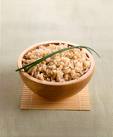
“Among cereal grains, brown rice is the most balanced. Its size, shape, color, texture, and proportion of carbohydrate, fat, protein, and minerals fall in the middle of the spectrum of the seven principal grains. Rice is particularly soothing to the brain and nervous system, our species’ most developed organs. Rice is now cultivated on every continent and may be considered humanity’s universal staple. (A. Kushi)
Millet
“Millet’s grains are round and compact but fluff up when cooked, producing a light, attractive dish. Because it grows in colder northern climates, millet is very warming to the body and most beneficial consumed in late summer or autumn. . . . Medicinally, millet is good for stomach, spleen, and pancreatic conditions. (A. Kushi)
Sea Vegetables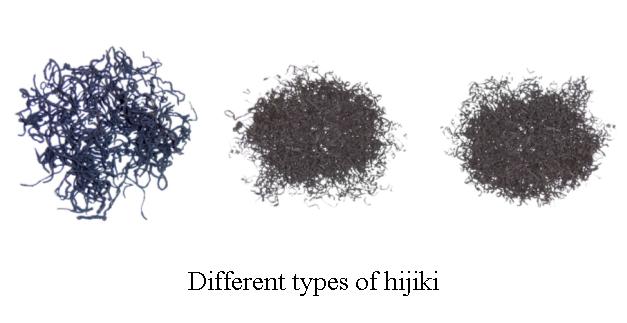
Hijiki (or Hiziki) Richest of all the seaweeds in calcium and iron – a good choice when you need to be able to standup under pressure. Known in Japan as “the bearer of wealth and beauty” hijiki is traditionally used to strengthen the bones, revitalize the skin and hair and build strong intestines (Turner).
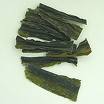
Kombu contains glutamic acid – a food tenderizer and flavor enhancer. It softens beans and makes them more digestible(Turner). It also contains high amounts of potassium, iodine, and calcium (Aihara). High in vitamins A, B2, C, kombu is therapeutic and protective against degenerative disease (A. Kushi).
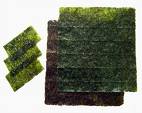
Nori is a good source of protein and vitamin A (beta carotene) (Turner). It also aids in the digestion of fats (Aihara). Nori is also high in B vitamins, vitamin C, calcium, and iron. Medicinally, nori is associated with relieving beriberi and reducing serum cholesterol (A. Kushi).
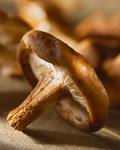
Shiitake Mushrooms are helpful in reducing blood serum cholesterol and boosting the immune systems. They are used to balance heavy animal food consumption (A. Kushi).
Round Vegetables
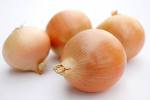
The family of round vegetables includes onions, cabbage, fall-and winter season squashes, cauliflower, and broccoli. These plants grow very near the ground, and their taste is usually sweeter than root vegetables, which grow beneath the 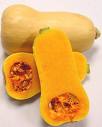 ground, or green and white leafy vegetables which grow above ground. Medicinally, round vegetables are soothing to the body. Cooked with squash and carrots, onions are highly recommended for people with diabetes (or hypoglycemia) who must watch their intake of simple sugars (i.e., sweet stew).
ground, or green and white leafy vegetables which grow above ground. Medicinally, round vegetables are soothing to the body. Cooked with squash and carrots, onions are highly recommended for people with diabetes (or hypoglycemia) who must watch their intake of simple sugars (i.e., sweet stew).
Root Vegetables
Root vegetables grow underground. They provide very stabilizing energy, focus the thinking, and strengthen the will. Root vegetables include carrots, parsnips, burdock, daikon radish, red radish, turnips, rutabaga, albi (taro) potatoes, jinenjo potato, and lotus root.
 Burdock (or Gobo) root is one of the most yang vegetables. It is especially goodfor the kidneys and sexual organs and for purifying the blood. (Aihara)It tones and strengthens the intestines, improves mental clarity, and helps reduce sweet cravings. Burdock is very alkalinizing and highly mineralized. It’s and excellent booster food when you feel run down from a cold or flu. (Turner)
Burdock (or Gobo) root is one of the most yang vegetables. It is especially goodfor the kidneys and sexual organs and for purifying the blood. (Aihara)It tones and strengthens the intestines, improves mental clarity, and helps reduce sweet cravings. Burdock is very alkalinizing and highly mineralized. It’s and excellent booster food when you feel run down from a cold or flu. (Turner)
 Carrots are good for alleviating eye and liver conditions. (A. Kushi) Helps tone and vitalize the spleen, pancreas and lymphatic system (Turner)
Carrots are good for alleviating eye and liver conditions. (A. Kushi) Helps tone and vitalize the spleen, pancreas and lymphatic system (Turner)
Daikon Radish “Cooked or raw, daikon aids in the digestion of whole grains 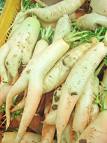 and vegetables. It also helps eliminate excess water and animal fats from the body and has a wide range of medicinal uses.” (A. Kushi) It dissolvesmucus, facilitates weight loss and reduces fever (Turner).
and vegetables. It also helps eliminate excess water and animal fats from the body and has a wide range of medicinal uses.” (A. Kushi) It dissolvesmucus, facilitates weight loss and reduces fever (Turner).
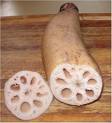 Lotus Root is very good for the lungs, helps relieve coughing and internal bleeding, and assists in draining mucus from the sinuses and lungs (A. Kushi)
Lotus Root is very good for the lungs, helps relieve coughing and internal bleeding, and assists in draining mucus from the sinuses and lungs (A. Kushi)
Condiments
Gomashio is good for those who have morning or motion sickness, food poisoning, heartburn, epilepsy, hiccups, menstrual cramps, loss of blood, or insomnia with fever. White sesame seeds grow in warm climates and have more oil but less minerals. Black sesame seeds have more minerals but less oil (Aihara).
Tamari is the liquid by-product of the miso-making process. Genuine tamari ismade without wheat, and is stronger tasting than regular soy sauce. Salty in taste it aids in contraction neutralizes an acidic blood condition, promotesblood circulation, relieves fatigue and generally calms and soothes (A. Kushi).
Beverages
Bancha Tea (Twig Tea; Kukicha Tea) is made from twigs and leaves from the tea plant that is a least three years old before harvesting. It has a low caffeine content, about one-fifth as much as green tea. The optimum proportion of twigs to leaves is considered to be six parts twigs to four parts leaves. Tea that is 100% twigs is called Kukicha twig beverage.
Bancha Tea is good for the circulation; for relieving fatigue, weakness, heart conditions, gonorrhea, and syphilis and for daily use. Also it helps purify the blood by removing toxins, and helps to satisfy the craving for yin foods (i.e.,sugar) after a meal (Aihara).
Grain Coffee (Yannoh) is good with bladder infections, loss of appetite, anemia, weak digestion, nervous debility, or constipation. This drink promotes clear thinking and a feeling of freshness (Aihara).
Juicing Recipes
Almost any fresh fruit or vegetable can be juiced. As a general rule, apples and carrots are neutral and can be mixed with almost anything. Except for lemons, do not mix citrus with vegetables or intestinal gas will result. Except for lemons, always peel citrus fruits. Try to buy organic fruits and vegetables. It does make a difference in quality and taste! Try to be open to the tastes and experiences. None of these juices will taste like those that are store bought. Drink them slowly, swirl the juice around in your mouth to mix it with the enzymes in your saliva. Enjoy!
These are some basic combinations that work particularly well:
Carrot, Apple, Ginger Juice
Pear, Apple, Ginger Juice
Pineapple, Kiwi, Orange Juice
Pineapple, Black Grape, Pear Juice
Carrot, Celery, Parsley And Lemon Juice
Kale, Wheat grass, Carrot
Alfalfa Sprouts, Carrots, Celery, Parsley
Carrot, Cabbage and Green Beans
Lemon, ginger, red grapes, green grapes
Books to help you on your journey into wellness:
Aihara, H. & Aihara, C. (1994). Natural Healing from Head to Toe. New York: Avery Publishing Group, Inc.
Balch, James & Balch, Phyllis (1996). Prescription for Nutritional Healing, 2nd Ed. New York: Avery Publishing Group
Balch, Phyllis & Balch, James (1992). Prescription for Cooking & Dietary Wellness. Greenfield, Indiana: P.A.B. Publishing.
Colbin, Annemarie (1989). The Natural Gourmet: Delicious Recipes for Healthy, Balanced Eating. New York: Ballantine Books.
Colbin, Annemarie (1996). Food and Healing. New York: Ballentine Books.
Crook, William. (1986). The Yeast Connection: A Medical Breakthrough. New York: Vintage Books.
D’Adamo, P.J. (1996). Eat Right For (4) Your Type: The Individualized Diet Solution to Staying Healthy, Living Longer & Achieving Your Ideal Weight. New York: Putnam.
Kushi, Aveline. (1985). Aveline Kushi’s Complete Guide to Macrobiotic Cooking for Health, Harmony, and Peace. New York: Warner Books.
Turner, Kristina. (1996). The Self-Healing Cookbook: A Macrobiotic Primer for Healing Body, Mind, and Moods with Whole, Natural Foods.Vashon Island, WA: Earthtones Press.